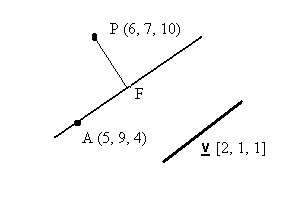Problem: |
||
| A diagram of this is shown on the right. |  |
P is the given point. OP is the position vector of the given point. The disc is a section of the plane. ON is the normal to the plane which passes through the origin O. n is the given vector to which the normal ON is parallel. M is the point where ON crosses the plane. F is the point where the perpendicular from P meets the plane. FP is the required distance. |
| A line is drawn from P, parallel to the plane and hence, at rightangles to ON, meeting ON at Q. |  |
Since FP and ON are both perpendicular to the plane and PQ is parallel to the plane then, MQ = FP. Therefore, the length MQ is equal to the required distance. |
| By inspection, MQ = OQ - OM |
OM is the perpendicular distance of the plane from the origin. This distance is given in the problem as 2. OM = 2 OQ is the projection of the vector OP on to ON which is parallel to the vector, n = [0, 4, 3] OQ is then, the scalar (dot) product of OP and the unit vector OQ = [3, 1, 5]. = We can now, finaly calculate MQ using; MQ = OQ - OM = = 1 |
|